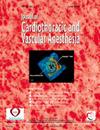超声引导下经小开胸行冠状动脉搭桥术患者的竖脊肌平面阻滞和前锯肌平面阻滞治疗急性疼痛:一项随机对照试验。
IF 2.3
4区 医学
Q2 ANESTHESIOLOGY
Journal of cardiothoracic and vascular anesthesia
Pub Date : 2025-02-28
DOI:10.1053/j.jvca.2025.02.045
引用次数: 0
摘要
目的:观察小开胸择期冠状动脉搭桥术患者应用竖脊平面(ESP)阻滞或联合前锯浅平面(SAP)阻滞镇痛效果。设计:随机对照研究。环境:手术室、重症监护病房和病房。患者:54例经小开胸行择期冠状动脉搭桥术。干预措施:将符合条件的患者随机分为单一ESP阻滞组(ESP组)或ESP+浅表SAP联合阻滞组(ESP+SAP组)。测量方法和主要结果:主要观察结果为皮肤闭合后6小时手术切口部位的动态数值评定量表(NRS)(咳嗽)评分。次要结局包括术后12、18、24和48小时手术切口的动态NRS评分,以及术后48小时内胸管、氢吗啡酮消耗、恢复质量和不良事件的NRS评分。与ESP组相比,ESP+SAP组在术后6小时(平均差异:-2.1,95% CI -2.8至-1.4,调整后p < 0.001)和12小时(-1.3,95% CI -2.0至-0.7,调整后p < 0.001)的手术切口动态NRS评分较低。ESP+SAP组在术后6小时(-1.4,95% CI -2.0至-0.9,调整p < 0.001)和12小时(-1.2,95% CI -1.7至-0.6,调整p < 0.001)的胸管动态NRS评分也较低。线性混合模型分析显示,ESP+SAP组手术切口和胸管的NRS评分低于ESP组(p < 0.05)。结论:与单纯ESP阻滞相比,ESP联合浅表SAP阻滞可降低经小开胸行冠状动脉搭桥术患者的疼痛评分。本文章由计算机程序翻译,如有差异,请以英文原文为准。
Acute Pain Management with Ultrasound-Guided Erector Spinae Plane Block and Serratus Anterior Plane Block in Patients Undergoing Coronary Artery Bypass via Mini-thoracotomy: A Randomized Controlled Trial
Objective
This study was designed to examine the analgesic efficacy of erector spinae plane (ESP) block or combined ESP and superficial serratus anterior plane (SAP) block in patients undergoing elective coronary artery bypass via mini-thoracotomy.
Design
Randomized controlled study.
Setting
Operating room, intensive care unit, and ward.
Patients
Fifty-four patients undergoing elective coronary artery bypass via mini-thoracotomy.
Interventions
Eligible patients were randomly allocated to single-ESP block (ESP group) or combined ESP and superficial SAP block (ESP+SAP group).
Measurements and Main Results
The primary outcome was dynamic numerical rating scale (NRS) scores (on coughing) for the surgical incision site 6 hours after skin closure. Secondary outcomes included dynamic NRS scores for surgical incision at 12, 18, 24, and 48 hours postoperatively plus NRS scores for the chest tube, hydromorphone consumption, quality of recovery, and adverse events within 48 hours postoperatively. The ESP+SAP group had lower dynamic NRS scores for surgical incision at postoperative 6 hours (mean difference: –2.1, 95% CI –2.8 to –1.4, adjusted p < 0.001) and 12 hours (–1.3, 95% CI –2.0 to –0.7, adjusted p < 0.001) compared to the ESP group. The ESP+SAP group also showed lower dynamic NRS scores for the chest tube at 6 hours (–1.4, 95% CI –2.0 to –0.9, adjusted p < 0.001) and 12 hours (–1.2, 95% CI –1.7 to –0.6, adjusted p < 0.001) postoperatively. Linear mixed-model analysis showed that NRS scores for the surgical incision and chest tube were lower in the ESP+SAP group compared to the ESP group (both p < 0.05).
Conclusion
Compared with ESP block alone, ESP combined with superficial SAP block reduced pain scores in patients undergoing coronary artery bypass via mini-thoracotomy.
求助全文
通过发布文献求助,成功后即可免费获取论文全文。
去求助
来源期刊
CiteScore
4.80
自引率
17.90%
发文量
606
审稿时长
37 days
期刊介绍:
The Journal of Cardiothoracic and Vascular Anesthesia is primarily aimed at anesthesiologists who deal with patients undergoing cardiac, thoracic or vascular surgical procedures. JCVA features a multidisciplinary approach, with contributions from cardiac, vascular and thoracic surgeons, cardiologists, and other related specialists. Emphasis is placed on rapid publication of clinically relevant material.

 求助内容:
求助内容: 应助结果提醒方式:
应助结果提醒方式:


